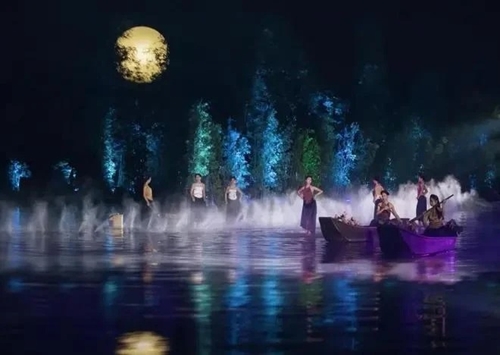Ha Van Sieu, Vice Director of the Vietnam National Authority of Tourism (VNAT), held that the diversity in culture, ethnicity, lifestyle, and the fusion of Eastern and Western culinary cultures have led to a diversity of unique Vietnamese dishes and drinks, satisfying various tastes of foodies. Street food and traditional dishes are also becoming a strength of Vietnam, bringing unique experiences to tourists, he held.
    |
 |
|
"Tinh hoa Bac Bo" (The Quintessence of Tonkin) show in Hanoi |
Besides, Vietnam is home to a treasure of 32 UNESCO-honored world heritage sites, including five cultural and 24 intangible cultural and documentary, not to mention the more than 40,000 relic sites across the country.
A large number of traditional crafts, unique skills, and a system of festivals and craft villages have also made up a huge resource for cultural tourism development, Sieu held.
Statistics from the World Food Tourism Association (WFTA) showed that 81% of foreign visitors are keen on exploring the local cuisine. They are willing to spend 25-35% of their budget on food and beverage expenses during their trips. Many famous Vietnamese dishes, such as pho (noodle), banh mi (Vietnamese sandwich), bun cha (rice vermicelli with grilled pork), and banh cuon (steamed rice roll) have been honored on many prestigious international media channels and become "ambassadors" of Vietnamese tourism.
The VNAT official said that over the years, Vietnamese tourism has been highly evaluated with many international prizes. Last year, Vietnam was honored by the World Tourism Awards as Asia's leading heritage, cultural and culinary destination.
Sieu underlined that by understanding the values of the local culture, tourists will continue to return to Vietnam.
Vu Van Tuyen, Director of Travelogy Vietnam, held that the cultural identity of regions, ethnic groups, and nations is what creates the attraction for tourists. Visiting cultural heritage sites in Vietnam is the second most popular activity among the international tourists, after resort tourism, he noted, stressing the need to connect heritage sites to build new routes for visitors.
He took Ha Long Bay in northern Quang Nam province and Hue city in the central province of Thua Thien Hue as examples of effective exploitation of heritage sites for tourism development. Last year, the Hue Monuments Complex, recognized as World Cultural Heritage in 1993, received 2.28 million visitors, including 1.03 million foreigners, while Ha Long Bay, a World Natural Heritage since 1994, welcomed nearly 2.7 million visitors.
Meanwhile, other heritage sites such as Hoi An city in Quang Nam and the Trang An Landscape Complex in Ninh Binh received 4 million and 6.6 million visitors in the year, respectively.
Vu The Binh, Chairman of the Vietnam Tourism Association (VITA), said that art programs that tell stories of culture and history of localities, regions and the nation across the country have become attractive among visitors.
A highlight in the panorama of cultural tourism development is the rising trend of engaging in the preservation and spreading of the beauty of cultural values of the nation and people of Vietnam through tourism among Vietnamese youngsters.
Many new tourism models have been created by the youth, opening new doors to the world, bringing the national traditional culture and the image of Vietnam to international friends.
Outstanding models include Khanh So ECO in Khanh Hoa, green tourism in Ho Chi Minh City, tourism linkage in Tuyen Quang, and the introduction of traditional culture through TikTok in Lao Cai.
Sieu said that he is extremely impressed by the capacity of the youth in maintaining and promoting national traditional values through tourism activities.
It is their patriotism and endless creativity that have led to their unique ways to introduce Vietnamese tourism and turn out unique tourism products, bringing new vitality to cultural tourism, Sieu stated.
Cultural tourism is a type of tourism developed on the basis of exploiting cultural values, contributing to preserving and promoting traditional cultural values, honoring new cultural values of humanity. Therefore, developing tourism associated with preserving and promoting cultural heritage values has been a major policy and orientation of the Party and State of Vietnam for many years.
According to Decision No.1755/QD-TTg issued on September 8, 2016, by the Prime Minister approving the strategy for developing cultural industries in Vietnam until 2020 with a vision to 2030, cultural tourism is one of the 13 cultural industries, which is expected to contribute 15-20% to the total 40 billion USD in revenue from tourists by 2030. Resolution No.82/NQ-CP dated May 18, 2023, on key tasks and solutions to accelerate the recovery and promote the effective and sustainable tourism development defines special priority of promoting tangible and intangible cultural values for developing tourism imbued with the Vietnamese cultural identity, as well as investing in the development of cultural industries with an emphasis on cultural tourism.
Source: VNA